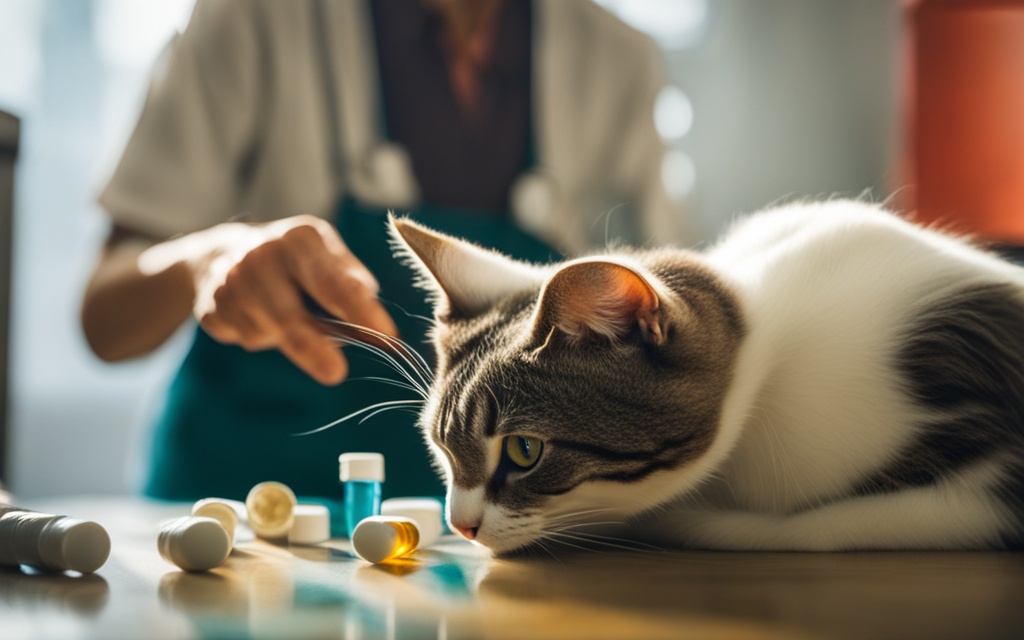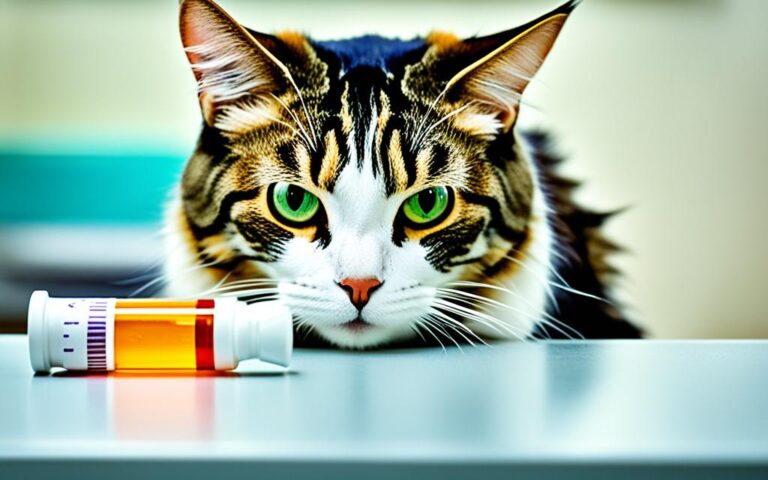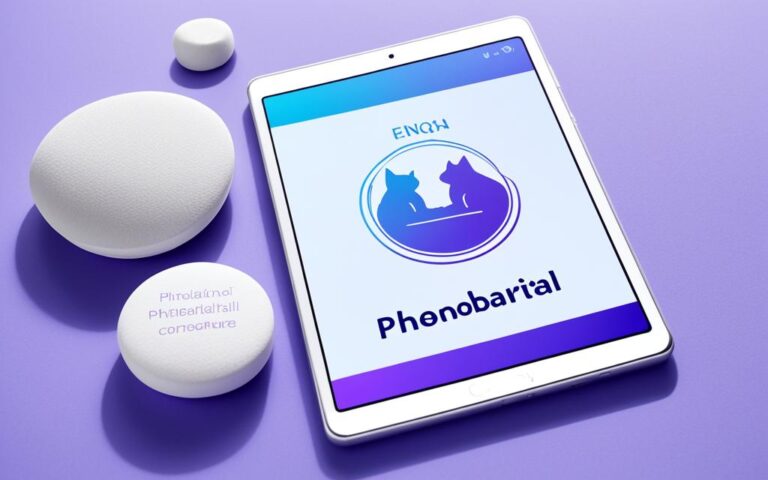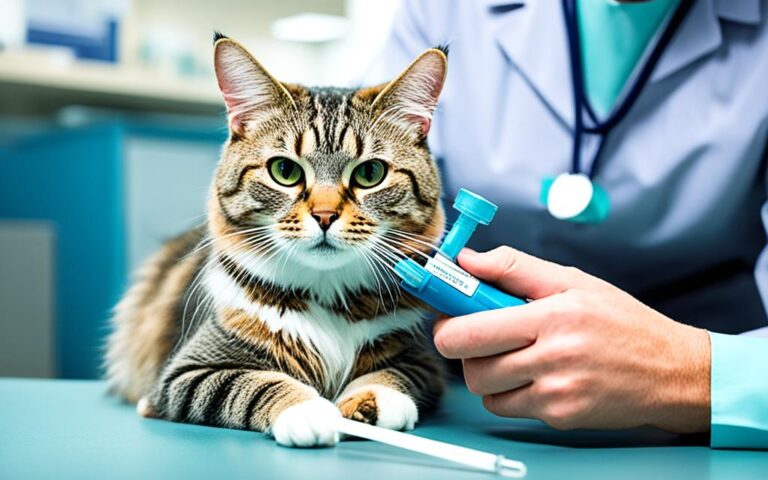Phenoxybenzamine for cats: Uses, Side Effects & Dosage
Roughly 1 in 10 cats will face a dangerous urinary blockage at some point1. This is when a cat cannot pee because something is blocking their urethra. For these serious cases, phenoxybenzamine can be a life-saving medicine.
This medicine, sold under brand names like Dibenzyline®, helps relax the muscles around the urethra1. This makes it easier for the cat to pee. It’s also used to treat high blood pressure from a rare adrenal gland tumor2. Even though it’s not specifically for cats, many vets use it because it works well for these issues1.
Sometimes, a regular medicine doesn’t fit a cat’s needs. Then, vets might order a specially made phenoxybenzamine1. This is because it’s not always about what’s been tested before, but what will help the cat the most.
Key Takeaways
- Phenoxybenzamine is a prescription medication used in cats to treat urinary obstruction and high blood pressure.
- It is not FDA-approved for veterinary use but is commonly prescribed off-label by veterinarians.
- Phenoxybenzamine can take several days to take effect and is often used with other medications.
- Potential side effects include nausea, vomiting, low blood pressure, and increased heart rate.
- Proper storage and monitoring are important when using phenoxybenzamine in cats.
Table of Contents
What is Phenoxybenzamine?
Phenoxybenzamine is an important medicine in veterinary care3. It’s known as an alpha-adrenergic blocker. This drug helps by relaxing muscles in the urethra3. It makes it easier for urine to pass, which is helpful for pets dealing with urinary issues3. It can also help manage high blood pressure in cats.
Overview of Phenoxybenzamine
Usually, phenoxybenzamine is given by mouth3. This can be as a pill or a special liquid mixture. It might take a day or two to start working3. Even though it’s okay for people, it’s not officially for animals. But, vets can use it in special cases, known as “off-label” or “extra-label” use3.
Approved Uses and Off-Label Applications
In cats, it’s used beyond its label to help with urinary and blood pressure issues3. It’s also been used in horses for certain conditions like laminitis3.
This drug can lower blood pressure in people4. And, dogs with a certain tumor sometimes have high blood pressure. Phenoxybenzamine is key in treating this condition in dogs4.
For horses, using phenoxybenzamine puts it in the ARCI class 3 group5. Research has looked into how it affects different parts of the body like the cat spleen. It’s also studied in relation to a substance called noradrenaline5.
Phenoxybenzamine for Cats: Uses
Phenoxybenzamine is a vital tool in treating cats with several health issues. It stands out in fighting urinary obstructions. This condition can be deadly, stopping cats from peeing because of a clog in their urethra6.
Treating Urinary Obstructions
It works by loosening the muscles around the urethra. This action helps ease the blockage, letting cats urinate again. Often, it teams up with drugs like prazosin for better results6.
Around 10% of cats may face this issue. And a big study showed that usual treatments didn’t work well. This is where phenoxybenzamine steps in7.
Older cats are more at risk, but young ones can get it too. In these cases, giving them special foods to drink more water or balance minerals might help prevent it7.
Managing High Blood Pressure
Phenoxybenzamine also helps with cat high blood pressure linked to pheochromocytoma. It’s a rare tumor in the adrenal glands. By blocking certain receptors, this drug can bring the cats’ high blood pressure down6.

“Phenoxybenzamine has proven to be a valuable tool in the management of various feline health conditions, particularly urinary obstructions and hypertension associated with pheochromocytoma.”
How Phenoxybenzamine Works
Phenoxybenzamine is key in helping cats with different health issues. It’s labeled as an alpha-1 antagonist. This means it stops the alpha-1 receptors in the urethral muscles from working8. By doing this, it helps the muscles relax and open up. This makes it simpler for the cat to pee. This action is a big part of why the drug is good at treating urinary blockages in cats8.
Mechanism of Action
Besides urinary problems, phenoxybenzamine can also lower high blood pressure. It does so by blocking those alpha-1 receptors that squeeze blood vessels8. This use is handy for cats with high blood pressure because of a pheochromocytoma. It’s a tumor in the adrenal glands8.
Benefits for Feline Health
The main pluses of phenoxybenzamine for cats include easing urinary blockages and managing high blood pressure. It works by calming the muscles of the urethra, getting rid of blockages and its dangers9. For cats with pheochromocytoma, it tames their high blood pressure. This helps take care of the cat’s heart health8.
There’s also talk that phenoxybenzamine may protect against certain ear issues in cats. These problems are often due to some antibiotics. More study is needed, but there’s a chance phenoxybenzamine could help or stop these ear troubles10.
To sum up, phenoxybenzamine’s role as an alpha-1 antagonist is key in treating cats. It helps with pee problems, high blood pressure, and maybe ear issues too. Knowing how this medicine works helps vets and cat owners make smart choices for their pets8910.
Dosage and Administration
The dose of phenoxybenzamine for cats depends on what the vet says, following the cat’s special needs11. This medicine is usually taken by mouth, either in capsules or liquid11. Normally, cats start with a dose of 2.5-5 mg, given two to three times each day11. The vet might change the dose to make sure it works just right.
Dosage Guidelines
In the case of cats, phenoxybenzamine is made into smaller pills by special pharmacies from 10-mg capsules11. The regular amount of phenoxybenzamine given to pets is 44 mg a day, varying between 10 and 240 mg a day11. But, this drug isn’t often used to open blood vessels in animals, unless they don’t respond to other drugs, like in cases of pheochromocytoma11.
Administering to Cats
It’s okay to give phenoxybenzamine with or without food, but food might help prevent upset stomach11. If you forget a dose, just give it when you remember. But if it’s almost time for the next dose, skip the missed one11.
And never give two doses at once to make up for a missed one.
| Medication | Mechanism of Action | Approved Uses | Dosage Range |
|---|---|---|---|
| Phenoxybenzamine | Non-selective irreversible alpha-adrenoceptor antagonist |
| 2.5-5 mg per cat, 2-3 times per day; average dosage of 44 mg/day (range: 10-240 mg/day) |
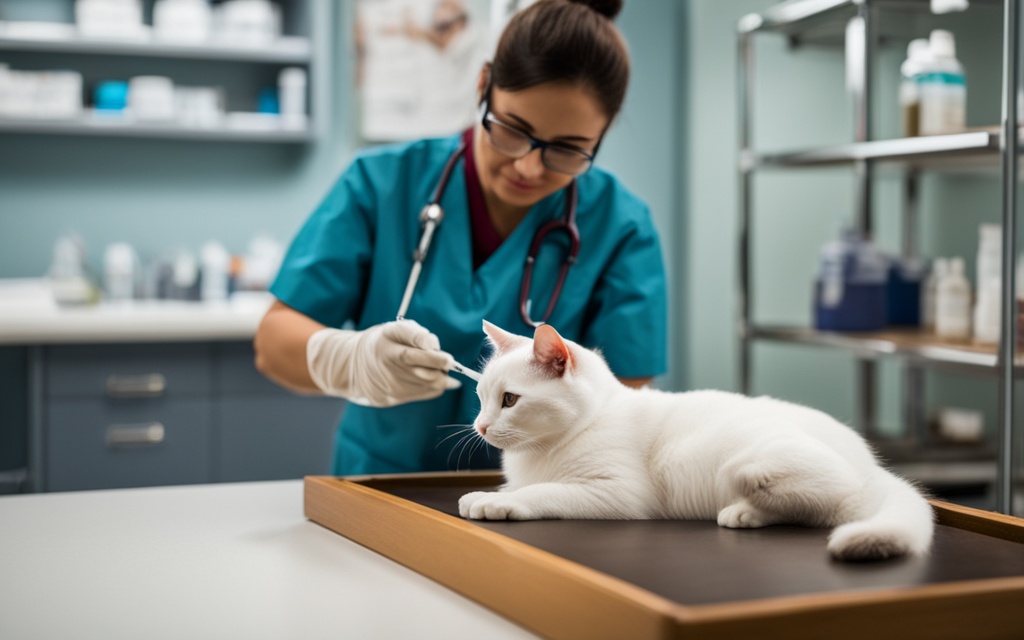
Treating with 2 mg per cat for 2 weeks after a urethral blockage can reduce the risk of it happening again in male cats11. Phenoxybenzamine might also help as a blood vessel opener in pets not helped by other drugs111213.
Potential Side Effects
Using phenoxybenzamine for cats comes with its own set of potential side effects. These can include nausea, vomiting, and weakness. This is often due to their blood pressure dropping too low (hypotension)14. Cats might also face issues like high blood pressure (rebound hypertension) or tiny pupils (miosis). They could have more eye pressure (glaucoma), a fast heart rate, stuffy noses, and trouble balancing (ataxia)14. Even after stopping the medication, these problems might stick around for a while, especially in cats with liver or kidney issues.
Precautions and Contraindications
Caution with phenoxybenzamine for cats is crucial, particularly if a cat has low blood pressure, high eye pressure, or known drug allergies14. It’s also not ideal for cats with heart or kidney troubles14. Before they prescribe it, vets think hard about whether the good effects outweigh the bad, especially for these cats.
Phenoxybenzamine contraindications in felines are cases where the drug should not be used. For instance, if a cat has a urethral obstruction, it’s a no-go15. Instead, they might use other drugs like prazosin in these situations15.
Before starting your cat on phenoxybenzamine treatment, make sure the vet knows about any health problems or other medicines your cat is on. This lets them figure out if the drug’s good effects win over the bad for your cat.
“Careful monitoring and regular veterinary check-ups are crucial when administering phenoxybenzamine to cats, as the medication can interact with other drugs and may require dosage adjustments based on the cat’s individual response.”
Drug Interactions
When giving phenoxybenzamine to cats, it’s key to think about drug interactions16. This drug, used for feline health issues, might not mix well with some others16. Owners need to tell their vet about any other meds or supplements their cat takes. This helps make sure phenoxybenzamine works safely and well.
Drugs that lower blood pressure can mix badly with phenoxybenzamine16. Also, epinephrine, phenylephrine, and reserpine might not go well with it16. It could need close watching and maybe a change in dose if these drugs are used together.
| Medication | Interaction with Phenoxybenzamine |
|---|---|
| Antihypertensive agents | Potential for interaction, requiring monitoring and dose adjustments |
| Epinephrine | Potential for interaction, requiring monitoring and dose adjustments |
| Phenylephrine | Potential for interaction, requiring monitoring and dose adjustments |
| Reserpine | Potential for interaction, requiring monitoring and dose adjustments |
It’s vital for owners to share all their cat’s medications with the vet17. Doing so makes phenoxybenzamine use safer and more effective, avoiding harmful interactions16.
Talking and working closely with the vet team can ensure the best care for cats16. Being up-to-date and listening to the vet’s advice is essential for the cat’s health during phenoxybenzamine treatment16.
Phenoxybenzamine for Cats: Monitoring and Storage
Veterinarians will keep a close eye on your cat when they prescribe phenoxybenzamine. They want to make sure the medicine works well without causing harm17. This means checking how much your cat pees, its blood pressure, and other signs. At home, owners should watch for any strange reactions in their cat. If they see something odd, they should call the vet right away17.
Monitoring During Treatment
Keeping track of your cat’s response to phenoxybenzamine is very important. Vets will adjust the dosage as they see fit17. In recent years, the use of this medicine for cats with potty problems has gone up a lot17. Studies show that many cat owners are happy with this medicine because it makes their cats feel better and cuts down on symptoms17.
Every cat is different, so the dosage might need to be changed for each one17. But, many cats do improve with the right amount of phenoxybenzamine. Making sure the medicine is stored correctly is key to its effectiveness over time17.
Proper Storage Instructions
Phenoxybenzamine must be stored just right, between 59°F and 86°F, in a closed container17. This keeps it safe from moisture and light. If it’s a compounded form, follow any special storage tips from the pharmacy. And remember, keep it away from kids and pets.
By watching your cat closely when it’s on phenoxybenzamine and storing the medicine well, both owners and vets help make sure it’s used safely and effectively17.
Comparison with Other Medications
Phenoxybenzamine helps with urinary blockages and high blood pressure in cats. Yet, there are other options like prazosin. These can also help with heart issues in cats18. The decision on which one to use depends on each cat’s unique situation. This includes what’s best for their health, the cost, drug availability, and side effects18. Veterinarians will choose the best medicine after looking at these factors.
Prazosin is one choice instead of phenoxybenzamine. A study found that cats on prazosin had less risk of blocked urethras than those on phenoxybenzamine19. Other drugs like meloxicam and prednisolone have been tested, but they didn’t help much19.
Urethra blockages can happen again in 15% to 65% of cats after treatment with phenoxybenzamine19. In rare cases, about 20% of these cats might have to be put to sleep19. This is why finding other medicines is important to help more cats get better without these risks.
| Medication | Approved Uses | Potential Benefits | Potential Drawbacks |
|---|---|---|---|
| Phenoxybenzamine | Urinary obstructions, hypertension | – Widely used – Effective for managing urinary issues and high blood pressure | – Recurrence rates can be high – Up to 20% of cats with refractory cases may require euthanasia |
| Prazosin | Urinary obstructions | – Lower risk of recurrent urethral obstruction compared to phenoxybenzamine | – Less extensively studied in cats |
| Meloxicam | Feline idiopathic cystitis | – Can be used to manage inflammation and pain associated with cystitis | – Did not show significant benefits in clinical studies for obstructive cystitis |
In short, while Phenoxybenzamine is often used for cats with certain issues, alternatives like prazosin also exist. Vets look at what each cat needs and what different treatments offer. This way, the chosen treatment can bring the best health results and safety.
Conclusion
Phenoxybenzamine is key in treating several cat health issues, like pee blockages and high blood pressure due to pheochromocytoma20. It works by relaxing the pee muscles and dropping blood pressure. This helps many affected cats, and they have a good chance of getting better, about 90% to 95%21.
This medicine is usually safe, but pet owners and vets need to be careful. Recurrence of pee blockages is common, happening in 15% to 40% of cases21.
Keeping a close eye on the cat, giving the right dose, and storing the medicine well are all very important20. It’s also vital to watch for side effects, like too much pee after the blockage clears. Knowing how this medicine works and its risks lets vets give the best care20.
Using phenoxybenzamine can really help cats, but it needs everyone to work together. With the right care from both owners and vets, cats can do well21. Knowing all about this medicine lets vets make good choices. This means they can provide top care for their cat patients22.
FAQ
What is Phenoxybenzamine?
What are the approved uses and off-label applications of Phenoxybenzamine in cats?
How does Phenoxybenzamine work to treat urinary obstructions in cats?
How does Phenoxybenzamine help manage high blood pressure in cats with pheochromocytoma?
What is the typical dosage of Phenoxybenzamine for cats?
What are the potential side effects of Phenoxybenzamine in cats?
What medical conditions or medications should be considered when prescribing Phenoxybenzamine for cats?
How should Phenoxybenzamine be stored for use in cats?
Are there any alternatives to Phenoxybenzamine for the treatment of urinary obstructions and hypertension in cats?
Source Links
- Phenoxybenzamine for Cats
- Uses, Dosage & Side Effects
- Phenoxybenzamine (Dibenzyline®) for Dogs and Cats
- Phenoxybenzamine for Veterinary Use
- Dual site of action of phenoxybenzamine in the cat’s spleen; blockade of alpha-adrenergic receptors and inhibition of re-uptake of neurally released norepinephrine – PubMed
- Idiopathic Feline Lower Urinary Tract Diseases: Therapeutic Rights & Wrongs – WSAVA 2003 Congress
- Finding Better Treatments for a Common Cat Condition
- Urethral pressure profile and hemodynamic effects of phenoxybenzamine and prazosin in non-sedated male beagle dogs
- Frontiers | Protecting Mammalian Hair Cells from Aminoglycoside-Toxicity: Assessing Phenoxybenzamine’s Potential
- Phenoxybenzamine – an overview | ScienceDirect Topics
- Feline Lower Urinary Tract Disease – WSAVA2006
- Actions of methoxamine and tryptamine and their interactions with cyproheptadine and phenoxybenzamine on cat spinal cord segmental reflexes – PubMed
- *
- A prospective randomized study of efficacy of 2 treatment protocols in preventing recurrence of clinical signs in 51 male cats with obstructive idiopathic cystitis
- Feline Idiopathic Cystitis – Where Are We Now? – WSAVA 2017 Congress
- THE INFLUENCE OF PHENOXYBENZAMINE ON THE STORAGE OF NORADRENALINE IN RAT AND CAT TISSUES – PubMed
- Managing Feline Urethral Obstruction
- A prospective randomized study of efficacy of 2 treatment protocols in preventing recurrence of clinical signs in 51 male cats with obstructive idiopathic cystitis

